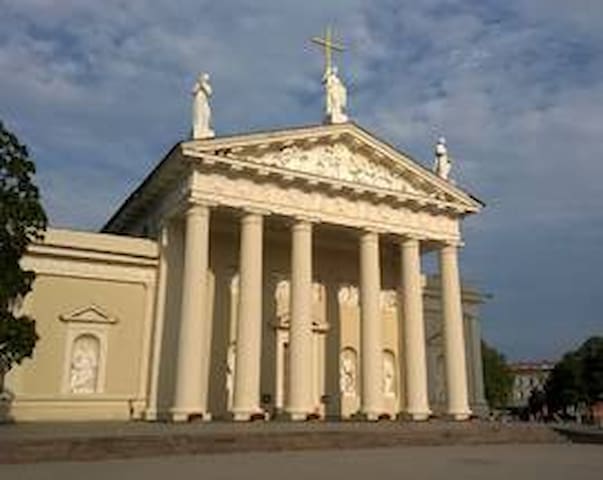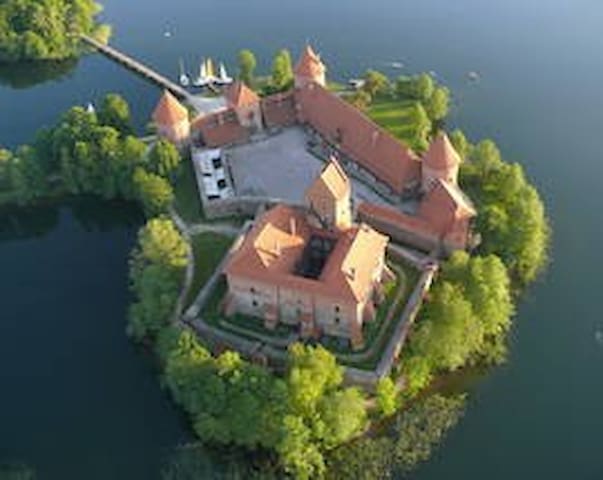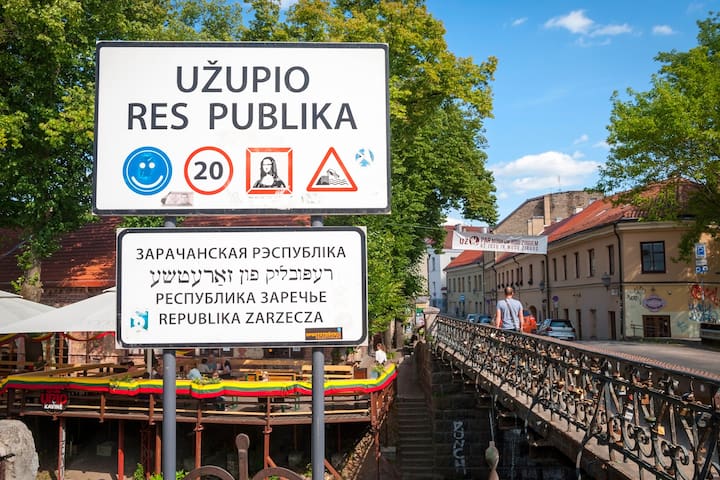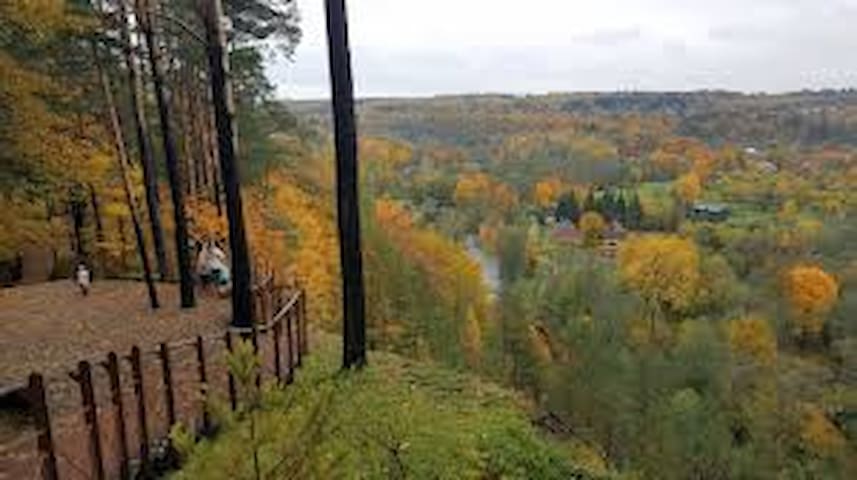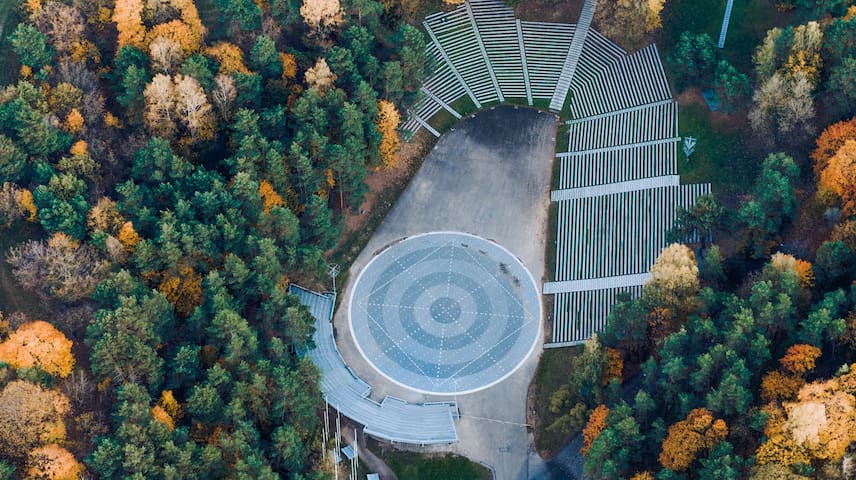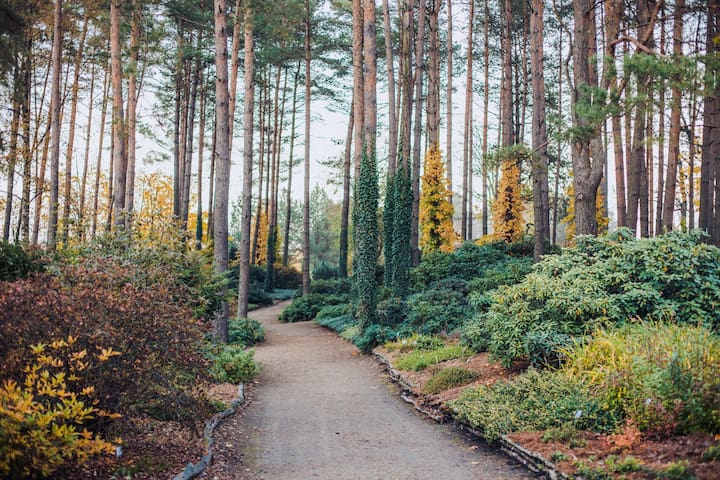Shopping malls
Key stores: Marella, Coccinelle, Michael Kors, Escada Sport, Suitsupply, Karen Millen, Stefanel, Max&Co., Weekend Max Mara, Pennyblack, Patrizia Pepe, Pierre Cardin, Baldessarini, Marc O’Polo, Samsonite, Strellson, Vapiano etc.
61 íbúar mæla með
Europa
7A Konstitucijos pr.Key stores: Marella, Coccinelle, Michael Kors, Escada Sport, Suitsupply, Karen Millen, Stefanel, Max&Co., Weekend Max Mara, Pennyblack, Patrizia Pepe, Pierre Cardin, Baldessarini, Marc O’Polo, Samsonite, Strellson, Vapiano etc.
The shops are small but varied, with eating and drinking options and sweeping river views.
21 íbúar mæla með
Prekybos centras CUP
9 Upės g.The shops are small but varied, with eating and drinking options and sweeping river views.
Akropolis is the largest shopping mall in the Baltics by floor area, a shopping center and entertainment center in Vilnius.
8 íbúar mæla með
AKROPOLIS Vilnius
25 Ozo gatvėAkropolis is the largest shopping mall in the Baltics by floor area, a shopping center and entertainment center in Vilnius.
OZAS shopping and entertainment center in Vilnius - special offers, joyful entertainment and new collections presentation.
109 íbúar mæla með
Ozas PPC
18 Ozo g.OZAS shopping and entertainment center in Vilnius - special offers, joyful entertainment and new collections presentation.
Lithuanian eats & drinks
This popular chain serves classic Lithuanian dishes in a folksy setting as well as more international food and that old favourite, the lunchtime special offer. An excellent value introduction to the wonders of local heart-blocking cuisine, Pilies Katpėdėlė rustles up salads with thick sauces, pancakes, pizzas, snacks from herring to potato wedges, creamy soups, main courses that include tasty sausages and fried salmon and some truly delicious desserts. Wash it all down with a beer or three.
Pilies KATPEDELE Restaurant
8 Pilies g.This popular chain serves classic Lithuanian dishes in a folksy setting as well as more international food and that old favourite, the lunchtime special offer. An excellent value introduction to the wonders of local heart-blocking cuisine, Pilies Katpėdėlė rustles up salads with thick sauces, pancakes, pizzas, snacks from herring to potato wedges, creamy soups, main courses that include tasty sausages and fried salmon and some truly delicious desserts. Wash it all down with a beer or three.
One of the best options for traditional Lithuanian dishes in Old Town, this is a jolly, warm-hearted, meat-and-potatoes place with welcoming cavernous rooms downstairs and window-side tables at street level. Feast and drink amongst antiquated folk utensils and cartoonish wall paintings and be served by smiling young locals in old-fashioned costumes. The potato pancakes with bacon and mushroom sauce are outstanding. Plenty of vegetarian options too.
46 íbúar mæla með
Etno Dvaras
16 Pilies g.One of the best options for traditional Lithuanian dishes in Old Town, this is a jolly, warm-hearted, meat-and-potatoes place with welcoming cavernous rooms downstairs and window-side tables at street level. Feast and drink amongst antiquated folk utensils and cartoonish wall paintings and be served by smiling young locals in old-fashioned costumes. The potato pancakes with bacon and mushroom sauce are outstanding. Plenty of vegetarian options too.
Šnekutis was selling craft beer before the term craft beer was even invented, and the man who began serving it was sporting a theatrical moustache when most people now running craft beer bars were still several years away from the needing to own a razor. Running out of several locations, this highly recommended and extremely popular watering hole continues to provide serious beer drinkers with a fabulous array of beers from local producers, some of them as wickedly strong as they are good. The traditional food’s pretty excellent too.
66 íbúar mæla með
Šnekutis
15 Šv. Mikalojaus g.Šnekutis was selling craft beer before the term craft beer was even invented, and the man who began serving it was sporting a theatrical moustache when most people now running craft beer bars were still several years away from the needing to own a razor. Running out of several locations, this highly recommended and extremely popular watering hole continues to provide serious beer drinkers with a fabulous array of beers from local producers, some of them as wickedly strong as they are good. The traditional food’s pretty excellent too.
Nice, sweet and cute place right in the Vilnius centre sells homemade style cakes, pies, patties and etc. Most recipes come from first part of XX century and including only natural ingredients. Natural ingredients and handiwork make prices a little bit higher. But You know for what You are paying and so after a few bit Your worst day becomes sunny.
15 íbúar mæla með
Pinavija Café & Bakery
21 Vilniaus g.Nice, sweet and cute place right in the Vilnius centre sells homemade style cakes, pies, patties and etc. Most recipes come from first part of XX century and including only natural ingredients. Natural ingredients and handiwork make prices a little bit higher. But You know for what You are paying and so after a few bit Your worst day becomes sunny.
It's probably the most popular place to hang out for Užupio locals, artists and travellers. If there's nice weather during your stay you should definitely come here and enjoy the outdoor terrace right on the banks of the river Vilnelė.
11 íbúar mæla með
Užupio kavinė
2 Užupio g.It's probably the most popular place to hang out for Užupio locals, artists and travellers. If there's nice weather during your stay you should definitely come here and enjoy the outdoor terrace right on the banks of the river Vilnelė.
Closest Grocery stores
IKI EXPRESS - ŽAL.TILTO
3 Kalvarijų g.Grocery store
Maxima XXX
11 Mindaugo g.Grocery store
Maxima XX
84 Naugarduko g.Closest restaurants/cafes
If you want a more authentic slavic experience, you should try Carskoje Selo – the caviar will still be there, but it is much (much much) more down to earth. The crowds are local Russians, and you will get a much better feel for their culture: if you go there on a Friday night, you might encounter large companies sitting at large tables, celebrating their family occasions, drinking vodka, dancing to the Russian music and having a good time.
Carskoje selo
1 Savanorių pr.If you want a more authentic slavic experience, you should try Carskoje Selo – the caviar will still be there, but it is much (much much) more down to earth. The crowds are local Russians, and you will get a much better feel for their culture: if you go there on a Friday night, you might encounter large companies sitting at large tables, celebrating their family occasions, drinking vodka, dancing to the Russian music and having a good time.
Vapiano
18 Konstitucijos pr.European cuisine
Manami
9 Saltoniškių g.Sightseeing
The most important Catholic building in Lithuania, Vilnius Cathedral as it’s more commonly known was first built in 1251 by newly converted Grand Duke Mindaugas on the site of a pagan temple.
31 íbúar mæla með
Cathedral Square
The most important Catholic building in Lithuania, Vilnius Cathedral as it’s more commonly known was first built in 1251 by newly converted Grand Duke Mindaugas on the site of a pagan temple.
One of the city’s most famous landmarks, St. Anne’s has a history that starts with the alleged construction in the 14th century of a wooden house of worship on this spot in honour of Ona, the wife of Vytautas the Great.
155 íbúar mæla með
Sankta Anna kirkja
8 Maironio g.One of the city’s most famous landmarks, St. Anne’s has a history that starts with the alleged construction in the 14th century of a wooden house of worship on this spot in honour of Ona, the wife of Vytautas the Great.
Dating from the 13th century, the castle was rebuilt by Grand Duke Vytautas after a major fire in 1419. By the early 1600s it was being used as a prison for disobedient members of the ruling classes, but during the chaotic 17th-century Russian occupation the towers and defensive walls were almost completely destroyed, with partial restoration work only beginning in 1930. Inside the tower are models of the structure as it appeared in the 14th and 18th centuries, plus other bits and pieces on its history. The views from the top are worth the visit alone.
260 íbúar mæla með
Gediminas Castle Tower
5 Arsenalo g.Dating from the 13th century, the castle was rebuilt by Grand Duke Vytautas after a major fire in 1419. By the early 1600s it was being used as a prison for disobedient members of the ruling classes, but during the chaotic 17th-century Russian occupation the towers and defensive walls were almost completely destroyed, with partial restoration work only beginning in 1930. Inside the tower are models of the structure as it appeared in the 14th and 18th centuries, plus other bits and pieces on its history. The views from the top are worth the visit alone.
A popular destination for visitors looking to get away from Vilnius for a few hours, the small town of Trakai is located less than 30km west of the capital and is easily reached by bus, train or car. First mentioned in 1337 by the Teutonic Knights and known for its many different inhabitants both past and present, among them Lithuanians, Jews, Poles, Russians, Tatars and the mysterious and now almost completely extinct Lithuanian Karaite, today most people are drawn to the town for its fabulous Gothic castle, although closer inspection reveals many more things to explore when in town.
79 íbúar mæla með
Trakai eyjaskáli
43C Karaimų gatvėA popular destination for visitors looking to get away from Vilnius for a few hours, the small town of Trakai is located less than 30km west of the capital and is easily reached by bus, train or car. First mentioned in 1337 by the Teutonic Knights and known for its many different inhabitants both past and present, among them Lithuanians, Jews, Poles, Russians, Tatars and the mysterious and now almost completely extinct Lithuanian Karaite, today most people are drawn to the town for its fabulous Gothic castle, although closer inspection reveals many more things to explore when in town.
The self-proclaimed “Republic” of Užupis is Vilnius’ Bohemian and artistic district. It has its own anthem, constitution, president, bishop, two churches, the Bernadine Cemetery – one of the oldest in the city -, seven bridges, and its own guardian called The Bronze Angel of Užupis, who was put in the centre of the district in 2002.
Dating back to the 16th century, Užupis is one of Vilnius’ oldest districts and despite its current prestigious status, was formerly the city’s poorest area and home to a number of manual workers and a red light-district.
During the Soviet era, the authorities let Užupis go to ruin, and it quickly gained notoriety as the roughest districts in the city. Since Lithuania regained its independence in 1991, artists came and took advantage of the cheap accommodation, and moreover, the city’s art academy is located across the bridge from Bernadinų Gardens. Now its thriving creative community hosts regular fashion festivals, concerts, exhibitions and poetry evenings.
In Lithuanian, Užupis means ‘behind the river’ and this is proclaimed in a number of languages on its entrance sign. The Vilnelė is the district’s river, and is home to Lithuania’s only mermaid – she’s not real, don’t worry! But she lives on the embankment, and those who give in to her charms will remain in Užupis forever.
74 íbúar mæla með
Uzupis
The self-proclaimed “Republic” of Užupis is Vilnius’ Bohemian and artistic district. It has its own anthem, constitution, president, bishop, two churches, the Bernadine Cemetery – one of the oldest in the city -, seven bridges, and its own guardian called The Bronze Angel of Užupis, who was put in the centre of the district in 2002.
Dating back to the 16th century, Užupis is one of Vilnius’ oldest districts and despite its current prestigious status, was formerly the city’s poorest area and home to a number of manual workers and a red light-district.
During the Soviet era, the authorities let Užupis go to ruin, and it quickly gained notoriety as the roughest districts in the city. Since Lithuania regained its independence in 1991, artists came and took advantage of the cheap accommodation, and moreover, the city’s art academy is located across the bridge from Bernadinų Gardens. Now its thriving creative community hosts regular fashion festivals, concerts, exhibitions and poetry evenings.
In Lithuanian, Užupis means ‘behind the river’ and this is proclaimed in a number of languages on its entrance sign. The Vilnelė is the district’s river, and is home to Lithuania’s only mermaid – she’s not real, don’t worry! But she lives on the embankment, and those who give in to her charms will remain in Užupis forever.
Atop one hill stands Gediminas Castle, and atop another- three crosses. This place is known to the residents of Vilnius as the Hill of Three Crosses, precisely because of the monument standing on it. The three white crosses, silently over-looking the Old Town of Vilnius were erected here during the Second World War and are now considered a symbol of our national identity as well as that of resistance to occupation. There are two legends about their origin: one of them claims that it is a memorial to the Franciscan monks who died in torture during the XIV c., while others say it is a mon-ument to Magdeburg’s rights having been granted to Vilnius. But one does not need a historical reason to visit here, as the magnificent panoramas of the city opening up at the top of this hill are enough. Take in the beauty of the city, while being surrounded by silence and peace, and if you fancy a yet another perspective, descend, cross Vilnelė river, and head to the top of Gediminas Castle Hill. 800 steps will get you there.
121 íbúar mæla með
Three Crosses
Atop one hill stands Gediminas Castle, and atop another- three crosses. This place is known to the residents of Vilnius as the Hill of Three Crosses, precisely because of the monument standing on it. The three white crosses, silently over-looking the Old Town of Vilnius were erected here during the Second World War and are now considered a symbol of our national identity as well as that of resistance to occupation. There are two legends about their origin: one of them claims that it is a memorial to the Franciscan monks who died in torture during the XIV c., while others say it is a mon-ument to Magdeburg’s rights having been granted to Vilnius. But one does not need a historical reason to visit here, as the magnificent panoramas of the city opening up at the top of this hill are enough. Take in the beauty of the city, while being surrounded by silence and peace, and if you fancy a yet another perspective, descend, cross Vilnelė river, and head to the top of Gediminas Castle Hill. 800 steps will get you there.
The five impressive Kernavė hills are one of the largest archaeological expositions in the open air, full of historical finds. Ironically, it is located on a relatively small 194 hectare piece of land, where the abundance of cultural values remains. The landscape formed in the course of history, is a testimony to the cultures that have existed in this area throughout 11 thousand years – from the late Paleolithic times (IXc. B.C.) to the present day. Sometimes flourishing and sometimes slow, life in the area has never ceased. The Kernavė Archeological Site, with its remaining artifacts that reflect the lifestyle of the last Pagan state in Europe is also unique in the way that its burial grounds and other archaeo-logical finds confirm the juncture and coexistence of Pagan and Christian cultures. True, part of the story still looms beneath our feet, so if you wish to see it up closer, head towards the Kernavė Archeological Site Museum, located 800 steps away.
10 íbúar mæla með
Kernavė
The five impressive Kernavė hills are one of the largest archaeological expositions in the open air, full of historical finds. Ironically, it is located on a relatively small 194 hectare piece of land, where the abundance of cultural values remains. The landscape formed in the course of history, is a testimony to the cultures that have existed in this area throughout 11 thousand years – from the late Paleolithic times (IXc. B.C.) to the present day. Sometimes flourishing and sometimes slow, life in the area has never ceased. The Kernavė Archeological Site, with its remaining artifacts that reflect the lifestyle of the last Pagan state in Europe is also unique in the way that its burial grounds and other archaeo-logical finds confirm the juncture and coexistence of Pagan and Christian cultures. True, part of the story still looms beneath our feet, so if you wish to see it up closer, head towards the Kernavė Archeological Site Museum, located 800 steps away.
Leisure: green spots
Žirmūnų paplūdimys
Žirmūnai Beach. Nearest bus stop – VALAKAMPIŲ TILTAS
Pūkorių atodanga
Pavilniai regional park with spectacular views.
Bernardine Park
8A B. Radvilaitės g.“Kalnai” means mountains or hills in Lithuanian, which would tell you what kind of a place to expect. However, we do not have mountains, so think the latter. Just around the corner from the Old Town, lies a park where you will discover the most famous hills of the capital: The Hill of Three Crosses, Gediminas Castle Hill, the Table Hill and Bekesh Hill. How does one tell them apart? That’s an easy one! The Hill of Three Crosses, believe it or not, boasts three crosses. Atop Gediminas Castle Hill, stands the only remaining tower. And the Table Hill is as flat and smooth as a tabletop. Which makes the fourth one Bekesh Hill. Voila. Now try and locate a stage that hides behind the Three Crosses monument. Many concerts and events take place here. Although it is just as great during the normal days. At the time of sunrise or in the evening, when the city lights up, a stunning city panorama opens up. Have a thing for city panoramas? Then you must visit all of the hills and admire Vilnius from above: the vibrant rooftops of the Old Town’s low-rise buildings, forests that adorn and encircle the city, and the rivers that playfully flow throughout it. You are looking right at the heart of the Lithuanian capital, pulsating with life, and yet stand in the midst of nature- precisely this is the true magic of Vilnius. With no better place to capture it, than Kalnai Park. And we promise you will not feel obliged to count steps here, as feet will carry you from one panorama to another themselves.
Kalnų parkas
“Kalnai” means mountains or hills in Lithuanian, which would tell you what kind of a place to expect. However, we do not have mountains, so think the latter. Just around the corner from the Old Town, lies a park where you will discover the most famous hills of the capital: The Hill of Three Crosses, Gediminas Castle Hill, the Table Hill and Bekesh Hill. How does one tell them apart? That’s an easy one! The Hill of Three Crosses, believe it or not, boasts three crosses. Atop Gediminas Castle Hill, stands the only remaining tower. And the Table Hill is as flat and smooth as a tabletop. Which makes the fourth one Bekesh Hill. Voila. Now try and locate a stage that hides behind the Three Crosses monument. Many concerts and events take place here. Although it is just as great during the normal days. At the time of sunrise or in the evening, when the city lights up, a stunning city panorama opens up. Have a thing for city panoramas? Then you must visit all of the hills and admire Vilnius from above: the vibrant rooftops of the Old Town’s low-rise buildings, forests that adorn and encircle the city, and the rivers that playfully flow throughout it. You are looking right at the heart of the Lithuanian capital, pulsating with life, and yet stand in the midst of nature- precisely this is the true magic of Vilnius. With no better place to capture it, than Kalnai Park. And we promise you will not feel obliged to count steps here, as feet will carry you from one panorama to another themselves.
The most beautiful wedding photos are born right here. And not without a reason. Just a few kilometers away from Vilnius, you will find yourself in an oasis of tranquility, nature and colors. You can spend an hour, two, an afternoon or the whole day in the botanical garden, visit once or come again and again. Whatever the amount of time- you will not be bored! The huge area is made up of thousands of beautiful plants, carefully looked after by professionals. While there are also plenty of natural corners, where seeds have been sown by the wind, watered by rain and raised by the sun. And what nature would not have animals reigning within? There are fish swimming and ducks floating in ponds. Walking a little further, you will find hedgehogs puffing and panting and rabbits scurrying about. Those more attentive may even spot raccoon dogs, martens, minks, ferrets, otters, wild boars and roe deer. In a nutshell, even if you are not planning to swap wedding rings here, photo opportunities are endless and you will end up with many snaps to add into your collection. The day passed as you strolled from one beauty to another? Rest your feet in Kalnai Park. Only a few hundred steps up the hill and you will be able to sit back and admire the panorama of Vilnius.
20 íbúar mæla með
Vilniaus universiteto botanikos sodas
43 Kairėnų g.The most beautiful wedding photos are born right here. And not without a reason. Just a few kilometers away from Vilnius, you will find yourself in an oasis of tranquility, nature and colors. You can spend an hour, two, an afternoon or the whole day in the botanical garden, visit once or come again and again. Whatever the amount of time- you will not be bored! The huge area is made up of thousands of beautiful plants, carefully looked after by professionals. While there are also plenty of natural corners, where seeds have been sown by the wind, watered by rain and raised by the sun. And what nature would not have animals reigning within? There are fish swimming and ducks floating in ponds. Walking a little further, you will find hedgehogs puffing and panting and rabbits scurrying about. Those more attentive may even spot raccoon dogs, martens, minks, ferrets, otters, wild boars and roe deer. In a nutshell, even if you are not planning to swap wedding rings here, photo opportunities are endless and you will end up with many snaps to add into your collection. The day passed as you strolled from one beauty to another? Rest your feet in Kalnai Park. Only a few hundred steps up the hill and you will be able to sit back and admire the panorama of Vilnius.
Museums
There is a reason why the palace website claims it is the Heart of Vilnius Museum. It is the birthplace of the city. It is precisely here that a wooden settlement existed in the IV-VIII century, part of which was turned into a stone castle in the XIII c. There were no princesses, locked up in towers, or dragons to be found here, however, it was home to almost all rulers of Lithuania. The castle grew bigger and more beautiful, and while it bore gothic characteristics at first, in the XV c. it was developed into a luxurious Renaissance palace. Unfortunately, the Moscow army of the XVII c. devastat-ed the site and, in the XIX c., destroyed it completely. Alongside the vanishing state, vanished, too, the rulers’ palace of the time. It was not rebuilt until 2009. Now you will find a functioning National Museum- Palace of the Grand Dukes of Lithuania. Which means you will get to feel like noblemen yourself during a visit! Strolling around the halls you will get to see carefully preserved ancient dishes, clothes and details of interior, and learn about how the elite of the day celebrated events, what they ate and even how they bathed. You are welcome to not only drop in on its permanent expositions and exhibitions, but also attend concerts, events, music and film festivals. And so, the palace that has spent many years in the void, has once again become the centre of attraction. Another Vilnius site, that has been given a second life, is Užupis- found in 1300 steps.
75 íbúar mæla með
Pöllustofa stórveldis hertuga Lítáen, Þjóðminjasafn
There is a reason why the palace website claims it is the Heart of Vilnius Museum. It is the birthplace of the city. It is precisely here that a wooden settlement existed in the IV-VIII century, part of which was turned into a stone castle in the XIII c. There were no princesses, locked up in towers, or dragons to be found here, however, it was home to almost all rulers of Lithuania. The castle grew bigger and more beautiful, and while it bore gothic characteristics at first, in the XV c. it was developed into a luxurious Renaissance palace. Unfortunately, the Moscow army of the XVII c. devastat-ed the site and, in the XIX c., destroyed it completely. Alongside the vanishing state, vanished, too, the rulers’ palace of the time. It was not rebuilt until 2009. Now you will find a functioning National Museum- Palace of the Grand Dukes of Lithuania. Which means you will get to feel like noblemen yourself during a visit! Strolling around the halls you will get to see carefully preserved ancient dishes, clothes and details of interior, and learn about how the elite of the day celebrated events, what they ate and even how they bathed. You are welcome to not only drop in on its permanent expositions and exhibitions, but also attend concerts, events, music and film festivals. And so, the palace that has spent many years in the void, has once again become the centre of attraction. Another Vilnius site, that has been given a second life, is Užupis- found in 1300 steps.



